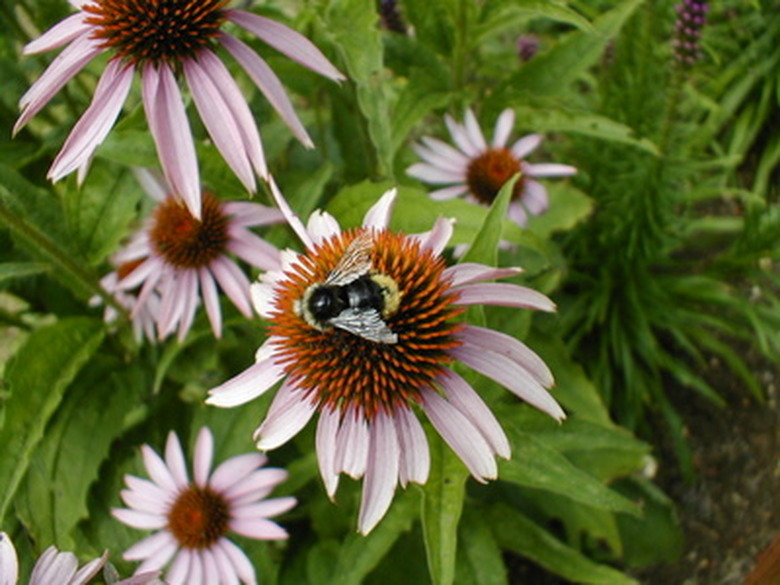How To Make A 3D Honey Bee Model
Honeybees are social insects vital to the health of many plants and ecosystems. They pollinate flowers as they move from one to the other gathering nectar. This pollination allows the plants to create seeds and reproduce. Honeybees are similar to all insects in their anatomy. They have six legs, a three-part body, compound eyes, antennae, jointed legs and a hard exoskeleton. You can make a simple model with clay and a few other craft items.
Step 1
Roll a small ball of yellow or orange clay that fits easily into the palm of your hand to create the head. Squeeze the ball gently between your hands to create an oval shape. Press the ball gently onto a flat surface on one side of the oval. Repeat on the opposite side to create a slightly pointed shape at one end of the head. This will be the front of the bee's head.
Step 2
Roll two small balls of black or brown clay, each approximately 1/3 of the size of the head. These are the compound eyes. Press them into either side of the head directly across from each other.
Step 3
Gently draw three small dots in the center on the front of the face below the compound eyes. These represent the simple eyes.
Step 4
Cut the thin pipe cleaner into sections approximately 2 inches long. These are the antennae. Insert each of the antennae into the head between the compound eyes. Bend the antennae slightly forward.
Step 5
Cut a piece of red string or yarn approximately 2 inches long. Insert into the lower front portion of the head. This represents the tongue. Then set the head aside.
Step 6
Roll orange or yellow clay into a ball slightly larger than the head for the thorax or center section. Press the ball between your hands slightly to create an oval shape.
Step 7
Cut six pieces of the thick pipe cleaners 3 inches long for legs. Insert three legs on each side of the body. Bend the legs so that 1 inch faces up and the rest slopes down and out away from the body.
Step 8
Review the honeybee diagram for the shape of the wings. Draw a template for the forewing and hindwing combined on the scrap paper. Cut out the template.
Step 9
Trace twice on the clear acetate. Cut out the acetate wings.
Step 10
Glue a toothpick along the long straight edge of each wing. The toothpick should extend forward of the wing so you can insert it into the body. Allow the glue to dry. Then insert the wings into the body.
Step 11
Roll a ball of yellow or orange clay that is twice as big as the head for the abdomen. Press gently between your hands to create an oval shape.
Step 12
Create black stripes to place around the abdomen using black clay. The stripes should only cover the back half of the abdomen.
Step 13
Break a toothpick in half. Insert the toothpick into the back of the abdomen so the point extends outside of the back. This is the stinger of a female honeybee.
Step 14
Partially insert a toothpick into the back end of the head of the honeybee. Press the front of the thorax onto the toothpick so the two sections join. Partially insert a second toothpick in the back of the thorax and press the front of the abdomen onto the toothpick so the thorax and abdomen are joined. Adjust placement of the body parts and the legs so the bee can stand.
Things Needed
- Diagram of honeybee
- Orange or yellow clay
- Black or brown clay
- Thin pipe cleaner – black or brown
- Scissors
- Red string or yarn
- Glue
- Thick pipe cleaners – black
- Scrap paper
- Pencil
- Clear acetate sheet
- Toothpicks
TL;DR (Too Long; Didn't Read)
Modeling foam is not as heavy as clay and may be easier to work with.
If you would like the model to be hardened at the end, use air-dry clay. Otherwise, use traditional oil-based modeling clay.
Cite This Article
MLA
Marcotte, Dawn. "How To Make A 3D Honey Bee Model" sciencing.com, https://www.sciencing.com/make-3d-honey-bee-model-6224786/. 22 November 2019.
APA
Marcotte, Dawn. (2019, November 22). How To Make A 3D Honey Bee Model. sciencing.com. Retrieved from https://www.sciencing.com/make-3d-honey-bee-model-6224786/
Chicago
Marcotte, Dawn. How To Make A 3D Honey Bee Model last modified March 24, 2022. https://www.sciencing.com/make-3d-honey-bee-model-6224786/
